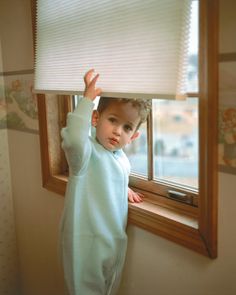Blinds are a common and useful window treatment that can provide light control, privacy and insulation. However, blinds can also pose a potential hazard for children, especially those with cords or chains that can form loops. According to the Royal Society for the Prevention of Accidents (RoSPA), at least 35 children have died in the UK since 1999 after becoming entangled in blind cords or chains. To prevent such tragic accidents, it is important to childproof your blinds and make them safer for your little ones. In this post, we’ll share some tips on how to childproof blinds and what to look for when buying new blinds.
To childproof blinds, you should keep cords or chains out of reach of children, use safety devices to secure or conceal them, move furniture away from windows, and check your blinds regularly for any damages or hazards. To buy new blinds, you should look for safe by design options that are cordless or have concealed or tensioned cords. You should also buy from reputable retailers that comply with the child safety standards and offer installation and maintenance services.
How To Childproof Existing Blinds
If you have existing blinds that have cords or chains that can form loops, you should take some steps to make them safer for your children. Here are some ways to childproof existing blinds:
- Keep cords or chains out of reach: You should pull the cords or chains as short as possible and keep them out of reach of children. You can also tie them up with a cord tidy, a tensioner or a cleat. A cord tidy or a tensioner is a device that holds the cord or chain taut and attaches it to an adjacent surface. A cleat is a device that wraps the cord or chain around it and fixes it to an adjacent surface. These devices should be positioned at least 1.5 metres from the floor and out of children’s reach.
- Use safety devices to secure or conceal them: You can use safety devices to secure or conceal the cords or chains of your blinds and prevent them from forming loops. These include a breakaway device, a chain-break connector or a cord/chain cover. A breakaway device is a device that breaks apart when pressure is applied to the cord or chain. A chain-break connector is a device that separates when pressure is applied to the chain. A cord/chain cover is a device that covers the cord or chain and prevents access to it.
- Move furniture away from windows: Children love to climb, so you should move furniture away from windows where they can access the cords or chains of your blinds. This includes cots, beds, highchairs, playpens and toys. You should also avoid placing any items on the window sill that can attract children’s attention1.
- Check your blinds regularly: You should check your blinds regularly for any damages or hazards that can pose a risk to your children. This includes broken or missing slats, loose or damaged brackets, faulty or worn-out cords or chains, etc. You should repair any damages promptly or replace your blinds if necessary.

What To Look For When Buying New Blinds
If you are buying new blinds for your home, you should look for safe by design options that are cordless or have concealed or tensioned cords. These can include spring-operated blinds, push-pull blinds, motorised blinds, wand-operated blinds or styles that can be lowered or tilted by hand1. Here are some tips on what to look for when buying new blinds:
- Buy from reputable retailers: You should buy from reputable retailers that comply with the child safety standards and offer quality products and services. Since 2014, all internal blinds made and sold in the UK must comply with specific child safety requirements1. This includes UK-based importers where the blinds may be made outside of the UK. You should look for retailers that are members of the British Blind and Shutter Association (BBSA) , which promotes window blind safety in homes and public buildings.
- Choose the right type of blind: You should choose the right type of blind that suits your needs and preferences without compromising on safety. There are many types of blinds available in the market, such as roller blinds, roman blinds, venetian blinds, cellular blinds, etc. Each type has its own advantages and disadvantages in terms of light control, privacy, insulation, style, etc. You should also consider the size and shape of your window and the material and colour of your blind.
- Consider the power source and control option: If you opt for motorised blinds, you should consider the power source and control option that suit your convenience and budget. There are two main types of power sources: battery and wired. Battery-powered blinds use a rechargeable battery that can be charged by plugging a charger into a wall socket or a USB port. Wired blinds use a hard-wired connection that can be plugged into an existing outlet or a junction box. There are four main types of control options: remote control, wall switch, smartphone app and smart speaker. Each control option has its own advantages and disadvantages in terms of convenience, accessibility, functionality and compatibility.
- Consider the integration with smart devices: If you want to enhance the comfort and functionality of your home, you can consider the integration of your blinds with other smart devices in your home, such as lights, thermostats, security cameras, etc. This can create scenes, routines and schedules that suit your needs and preferences. For example, you can set your blinds to open at sunrise, close at sunset, adjust according to the weather, etc. The integration with smart devices depends on the compatibility of your blinds with different platforms and protocols, such as Alexa , Google Assistant , HomeKit , IFTTT , Z-Wave , Zigbee , etc.
- Ask for installation and maintenance services: You should ask for installation and maintenance services from your retailer or a professional installer to ensure that your blinds are installed correctly and safely. Installing your blinds yourself can save you money on labour costs, but it may also require some skills and tools that you may not have. You should also make sure that you follow the instructions carefully and safely to avoid any mistakes or damages. You should also ask for maintenance services from your retailer or a professional installer to ensure that your blinds are functioning properly and safely. You should check your blinds regularly for any damages or hazards and repair them promptly or replace them if necessary.

Final Thoughts
Blinds are a common and useful window treatment that can pose a potential hazard for children if they have cords or chains that can form loops. To prevent such tragic accidents, you should childproof your blinds and make them safer for your little ones. To childproof existing blinds, you should keep cords or chains out of reach of children, use safety devices to secure or conceal them, move furniture away from windows, and check your blinds regularly for any damages or hazards. To buy new blinds, you should look for safe by design options that are cordless or have concealed or tensioned cords. You should also buy from reputable retailers that comply with the child safety standards and offer installation and maintenance services.
Dale is the colorful mind behind HuetifulHomes.com, where he shows you how to create a home that is as fun and fabulous as you are. He has a passion for color and a knack for DIY, with years of interior design experience he shares his tips and tricks on how to create a home that reflects your personality and style. He believes that color is the key to happiness, and he wants to help you make your home more Huetiful.



